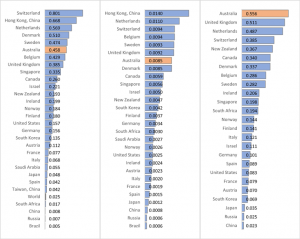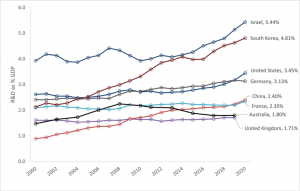by NICHOLAS FISK and THOMAS CHOW
As our summerfest of sport draws to a close, the focus on performance and statistics is mainly at individual level but also touches on national competitiveness.
Similarly, the Aggregate Ranking of Top Universities (ARTU) positions individual universities globally based on overall performance across the major scoring systems. But it’s ARTU’s country comparisons that provide a window into the efficiency and thus return on investment of national higher education systems.
The latest edition references performance to Gross Domestic Product (GDP) and Research & Development (R&D) expenditure in addition to population. Although Switzerland has the highest number of universities in the top 200 per capita and Hong Kong the most relative to GDP, it’s Australia that leads the way when adjusted for national R&D expenditure. This is no fluke, with Australia also in pole position for the number of top 100 and top 300 institutions per R&D dollar.
per capita millions GDP billions $US R&D billions
$US
Although the US and UK dominate the rankings in absolute terms, China and Australia have been the movers if not shakers over the last decade. Globally, Australia now ranks third with 8 per cent of top 100 and = fourth with 6 per cent of top 200 universities, remarkable for a country with only 0.3 per cent of the world’s population, 1.7 per cent of global GDP and <1.5 per cent of the OECD’s R&D expenditure.
Unlike China however, Australia performs strongly in relative terms when its number of top 100 and 200 institutions are adjusted by population (both sixth) and GDP (fourth and seventh respectively). But it’s relative to research and development expenditure that we’ve had the gold medal for top 200 numbers since 2019.
No other country can boast that each of its universities listed in the top 200 is based on an average of <1.8B constant US dollar R&D spend adjusted for purchasing power parity.
Whichever way you look at it, Australia’s research-intensive universities are up there among the world’s best. This paints Australia’s universities as delivering incredible value for money. Yet the higher ed sector almost uniformly bemoans low levels of investment -is this crying wolf? Have we shot ourselves in the foot by being too efficient?
Low R&D investment
Gross domestic R&D spend is admittedly a rather blunt tool, reliant on self-reporting, estimation and even methodology changes, but it does offer insight into relative investment across different countries.
Australia’s R&D spend at 1.8 per cent of GDP is the lowest it’s been since 2004. As the denominator, this will be a major factor in us being in the lead for number of Top 200 universities/R&D dollar for four years on the trot.
But there is also the rankings numerator, so holding onto this accolade downstream may be in doubt, especially as R&D investment takes years to reflect in research performance, translation, and impact.
R&D investment as per centage of GDP – Australia, China, France, Germany, Israel, South Korea, United Kingdom, and United States
Perhaps our universities’ strong performance now can be traced back to around a decade ago when Australian R&D funding peaked. However, other countries such as the US, South Korea, and Germany have invested much more year-on-year, without this efficiency dividend. Might R&D in those nations be targeted more at business and government entities than at universities? Or could Australia’s healthy mix of collaboration and competition between universities be at play?
Falling further behind in R&D
That Australia’s R&D investment has gone backwards over 10-15 years is a concern, but even more so in contrast with other countries that have upped funding in both absolute and relative terms.
Across the OECD, average R&D as per centage of GDP since 2010 has grown 0.43 per cent to 2.67 per cent. Indeed some advanced economies such as the US, South Korea and Israel not only start from a higher base but increased their R&D spend/GDP even more (+0.74 per cent to +1.51 per cent). China isn’t far behind, having increased 0.69 per cent and with plans to go further.
The graph below exposes Australia’s unenviable performance, as one of only five countries to go backwards over the last decade.
Decadal change in R&D as % of GDP in OECD denoted by hollow (2010) & filled (2020) circles
It’s hard to avoid the conclusion that Australia has been asleep at the wheel in terms of nurturing its research ecosystems. COVID has highlighted our vulnerabilities not only in university business models but in R&D dependent sovereign capability. National reconstruction is fine, but it is international catch up in R&D investment that’s now needed.
Australia’s university sector is clearly doing well, despite operating in a globally-distant low-investment environment, overly reliant on international student income and weak indirect cost coverage. What distinguishes it globally however is its seeming efficiency (defined here as top universities per national R&D spend). We argue this is a denominator more than a numerator issue, reflecting Australia’s woeful investment in R&D, and must not foster complacency.
Fortunately our nation’s paltry investment seems set to change, with federal industry minister Ed Husic setting a goal to increase R&D to 3% of GDP. This is hardly a stretch target, as nine advanced economies already exceed it, but would be a most welcome start.
Nicholas Fisk is DVC (Research and Enterprise) and Thomas Chow is Director, (Research Analysis, Data and Reporting) at UNSW Sydney
The new edition of UNSW’s Aggregate Ranking of Top Universities is HERE.


